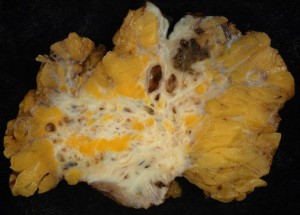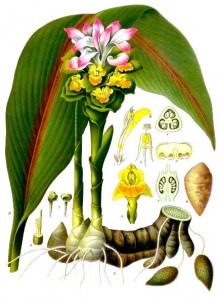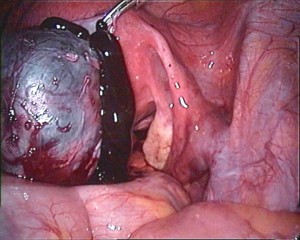
Endometriosis is a painful condition where the tissue normally inside of the womb, the endometrium, is found in other parts of the body. The endometrial cells build up blood for pregnancy, which is shed during menstruation. However if this tissue is found outside of the womb, it can cause bleeding in areas where blood is not supposed to be shed and it can cause major pain and inflammation. Typically areas of endometrium are found near the ovaries or fallopian tubes, the anterior or posterior cul de sacs of the exterior uterus, the peritoneum of the pelvic wall, the sigmoid colon or ureters, but it can be found as far away as the diaphragm, the lungs or the nose. Surgical incisions can be populated with endometrial tissue as well.
The causes are largely unknown. In some cases, the endometrial cells may be shed along with the menstrual blood, only to migrate to areas where they can attach to other structures. It is widely believed in Europe, for example, that sexual intercourse during the menstrual period can cause the vaginal vault to expand, permitting endometrial cells to get into areas where they otherwise would not, pushed upward by the sexual act. In Chinese medicine, sexual intercourse is seen as an upward, yang act which should not take place during the powerful yin periods where the body is and should be focusing downwards.
However in other cases there seems to be parallel development of extra-uterine endometrial cells. It seems highly unlikely that endometrial cells in the nose, which result in menstrual nosebleeds or in the lungs, have migrated from the womb. Since most cells in the human body can differentiate into any necessary structure, it is likely that the instructions for differentiation were incorrectly expressed. The process is estrogen dependent and may even persist beyond menopause.
Approximately 10 to 15% of women during their reproductive years are believed to suffer from endometriosis, including approximately 20-50% of those with primary infertility and 60% of those with pelvic pain. Current estimates are that 30-47% of women suffering from this disorder are infertile. A 1988 survey conducted in the US found significantly more hypothyroidism, fibromyalgia, chronic fatigue syndrome, autoimmune diseases, allergies and asthma in women with endometriosis compared to the general population. It seems to affect women with late pregnancies or no pregnancies worse, possibly because cysts can more easily build up.
Symptoms of endometriosis include pelvic pain, painful periods, pain between periods during bowel movements or other actions, painful sexual intercourse, nausea, dizziness, bleeding during menses in unlikely areas, blocked bowels, fever during menstruation and dysfunctional uterine bleeding. Current research has demonstrated an association between endometriosis and certain types of cancers, notably ovarian cancer, non-Hodgkin’s lymphoma and brain cancer but not endometrial cancer. Complications of endometriosis include:
* Internal scarring which can lead to infertility
* Adhesions
* Pelvic cysts
* Chocolate cysts which are endometriomas filled with old blood
* Ruptured cysts where exit of the eggs from the ovaries is blocked
* Blocked bowel/bowel obstruction
* Infertility
Infertility can be related to scarring and anatomical distortions due to the endometriosis. However, endometriosis may also interfere in more subtle ways: cytokines and other chemical agents may be released that interfere with reproduction.
In Chinese medicine, endometriosis is seen as a kind of Blood or Phlegm stagnation. The main goal of treatment for endometriosis is to strongly move the blood to flush out stagnation. Herbs like dang gui, cyperus, red peony, safflower stamens, motherwort, ligusticum, persica seed, zeodary, red sage root and fennel seed may be used to strongly move blood. Pain killers like corydalis or Jamaica dogwood, frankincense and myrrh may be given.
 There are five basic patterns that accompany blood or phlegm stagnation:
There are five basic patterns that accompany blood or phlegm stagnation:
- Qi Stagnation and Blood or Phlegm Stasis.
- Kidney Deficiency and Blood or Phlegm Stasis.
- Cold Retention and Blood or Phlegm Stasis.
- Qi Deficiency and Blood or Phlegm Stasis.
- Heat Obstruction and Blood or Phlegm Stasis.
 In addition there may be patterns of Qi stagnation, Qi deficiency, Kidney deficiency, Cold stagnation or Heat stagnation. Different herbs are used for each condition. Common formulas, depending upon the pattern, include Shi xiao san, Shaofu zhuyu, Xue fu zhu yu tang, and Nei yi wan.
In addition there may be patterns of Qi stagnation, Qi deficiency, Kidney deficiency, Cold stagnation or Heat stagnation. Different herbs are used for each condition. Common formulas, depending upon the pattern, include Shi xiao san, Shaofu zhuyu, Xue fu zhu yu tang, and Nei yi wan.
Western herbs that may help endometriosis focus on the liver, like dandelion and vitex. This helps normalize the estrogen dominance along with dietary change. In addition pain relief from Indian pipe, Jamaica dogwood or sweet melliot can be useful. Angelica and saffron may be used to move the blood, along with nutgrass tubers and frankincense or myrrh.
 Uterine massage may be used to reduce stagnation in the pelvic area. This combines proper placement of the uterus, which can flop forward or backwards in its hammock of ligaments with flushing of the lymphatic ducts and blood vessels in the pelvis. Acupuncture is frequently used to move blood and treat the underlying pathology. Further acupuncture affects hormonal balance, which can help correct underlying conditions or at least moderate their effects.
Uterine massage may be used to reduce stagnation in the pelvic area. This combines proper placement of the uterus, which can flop forward or backwards in its hammock of ligaments with flushing of the lymphatic ducts and blood vessels in the pelvis. Acupuncture is frequently used to move blood and treat the underlying pathology. Further acupuncture affects hormonal balance, which can help correct underlying conditions or at least moderate their effects.
Castor oil packs are a time tested way of getting relief from pelvic pain. A cotton or wool flannel cloth is soaked in castor oil, to which a few drops of clary sage essential oil may be added. The cloth is laid over the abdomen, covered by a piece of plastic to protect towels and bedding from oil stains, covered with a hot towel or a towel and heat source such as a hot water bottle or heating pad. This is mostly palliative although it will enhance pelvic circulation.
Standard western treatment includes birth control pills which suppress but do not cure the condition, surgical removal of endometrial tissue although it frequently grows back, total hysterectomy and drugs. Drug therapy for endometriosis is often unsatisfactory. Most of the current drug therapy is aimed at altering the estrogen-based hormonal stimulus of the endometrial tissue, like progestins, testosterone or gonadatrophin-releasing hormone. The condition is not easy to treat with any modality, but treatment, diet and lifestyle changes can help manage it.
Diet plays a significant part in the treatment of endometriosis. This is one case where coffee is actually contraindicated. High fiber foods, sea vegetables, fruits and vegetables, and low levels of fish or lean pasture-raised meat are recommended. Dairy and soy should be avoided since they are estrogenic and may be aggravating to autoimmune conditions.
Anti-inflammatory supplements such as curcumin or turmeric, fish oil, evening primrose oil, and clary sage can be taken. Vitamin D levels should be brought up so that blood levels of 25hydroxy D3 are 50-100. Calcium and magnesium levels should be balanced and magnesium increased. You should also keep up antioxidants, flavanoids and adaptogenic herbs like astragalus, ginseng or holy basil.
Support groups and computer forums can offer significant support, as well as a group of people who have experienced different types of treatment. Check out http://www.mdjunction.com/endometriosis
See also:
http://www.acupuncturebrooklyn.com/how-tos/how-to-use-a-castor-oil-pack-by-karen-vaughan on how to make a castor oil pack.
http://www.itmonline.org/journal/arts/endometriosis.htm for an exhaustive article on Chinese medicine and endometriosis

